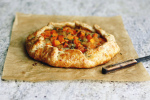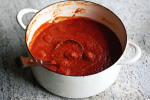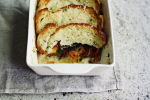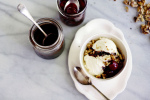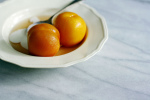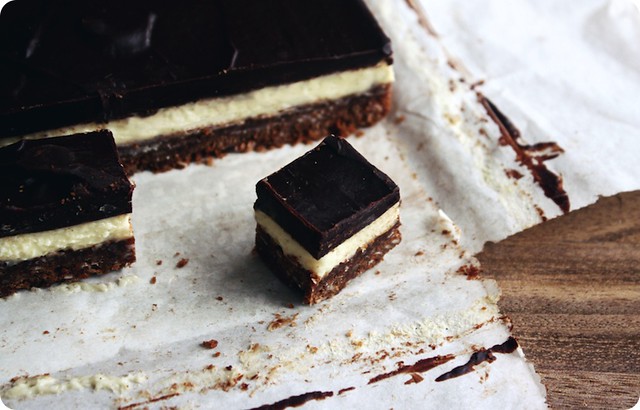Marvelous, golden
 Wednesday, February 23, 2011 at 10:51AM
Wednesday, February 23, 2011 at 10:51AM Once Molly (Wizenberg) wrote of wanting "pâte brisée for a pillow", and it was a statement so perfectly, poetically apt that it's stuck with me. With ardent hope she doesn't mind the tug at her coattails, I submit that if a puff of pastry is where you'd lay your head, with a bed of onions beneath, you just might desire the layers of a potato gratin for bedclothes.
I see that my addition stretches her neat metaphor into something excessive in it's total carbohydrate intake, but the sentiment holds true - potato gratin and an Alsatian Onion Tart hit very much the same notes of butter, cream and those marvelous, golden flavours brought about in baking. A good potato gratin has a gentle crisp at its top, a smoothly-set layering of potato and cream underneath, where the neat strata of each ingredient may be appreciated by the eye, but is hardly so to the tooth.
This gratin comes by way of David Tanis, from his latest book The Heart of the Artichoke, and it is my idea of what a gratin should be. Too often we're offered watery, weepy versions, where the potatoes are wholly undercooked or are gravely underseasoned. Tanis's gratin is as simple as simple can be, held only to the essential ingredients and arranged in unvarnished, glorious harmony.
Actually, this whole book is my idea of what a cookery book should be. There's an easy conversation to be found on his pages that appeals - the tone is that of reading the words of a friend, a very smart, very talented friend, but a friend all the same. The recipes are arranged in seasonal menus with notes on cooking and gentle suggestion of technique. His tastes are varied, so you'll find jalapeno pancakes, black sticky rice pudding with coconut cream, and roast suckling pig (not all together).
Look at me go on. I've been distracted completely from what we're supposed to be talking about. Let's just say it's a really good book and leave it at that.
This potato gratin. We had this over the weekend, the Jansson's Temptation variation (that's fun to say), if we're getting into details. It was a long weekend; a statutory holiday in some parts of Canada. Such lazy days are the ideal setting to potato gratin, as they do take time. Not to make or eat, but to let them cook slowly and languidly so that they reach the velvety standard we're all hoping for.
This won't let those hopes down. It's the gratin to end them all, with my special fondness tied to the Jansson's as said. The onion sweetens the cream slightly, and the anchovies mitigates all with a profound salinity. Eaten the next morning, warmed moderately with a poached egg and a salad of the most peppery, bitterest greens you can find, it's exceptional.
******
In nice bit of news, Sheri and Shari kindly invited me to visit their marvelous site this joy+ride. We had a chat about winter and cooking, and there's lots of photographs to share. If you'd like to take a look, here it is. You'll note I talk about Tanis there, so sharing this recipe today felt right.
Thank you dear ones for having me.
******
Classic Potato Gratin
From the book The Heart of the Artichoke by David Tanis, (Thomas Allen and Sons, 2010).
A good gratin is probably the only thing you can serve at any dinner table that everybody will love. Of all the versions, I prefer this tradition French-style gratin, made simply with potatoes, cream and butter.
Ingredients
3 pounds baking potatoes (use medium russet, Bintje, or German Butterball)
Salt and pepper
4 tablespoons butter, plus a little more for the baking dish
2 1/2 cups organic heavy cream, or as needed
Preheat the oven to 375°F. Peel the potatoes and put them in a bowl of cold water. Smear a baking dish thickly with butter. My favorite gratin dish is a circular pan 14 inches in diameter and 2 inches deep. If you don't have a large dish, make 2 smaller gratins. Just make sure the dish is not too deep.
To assemble the gratin, place a cutting board on the counter between the bowl of potatoes and the baking dish. Using a mandoline, if you have one, slice a few potatoes at a time, as thin as possible. Quickly lay the potato slices in the bottom of the pan, overlapping them to make one layer. Sprinkle lightly with salt and pepper. Slice a few more potatoes and make another layer. Continue in this fashion, seasoning each layer, until all the potatoes are used.
Pour the cream over the potatoes and tilt the pan to distribute it well. With your hand, push down on the top layer to even out the pile. The cream should just barely cover the potatoes. Add a little more if necessary. Dot the surface with the butter, then cover the dish tightly with foil and put it in the oven. Bake for 30 minutes.
Remove the foil and return the pan to the oven for another 30 minutes or so to brown the top of the gratin. Let the gratin rest fot 10 minutes before serving. (The gratin can also be cooled and left at room temperature for several hours, and reheated in a moderate oven.)
{GRATIN VARIATIONS}
Obviously, there are many other delicious ways to make a gratin. For a good cheesy version, sprinkle an assertive cheese, such as a Swiss Gruyère or Raclette, or even Fontina, between each layer of potatoes. You'll need about 2 cups of grated cheese.
There's a Swedish version of the dish called Jansson's Temptation, which calls for anchoivies and onions and is excellent for breakfast or lunch. To make a good approximation of Jannson's, I mix 1 large onion, sliced thin, with about 12 anchovy fillets, rinsed and roughly chopped, and divide the mixture among the layers. Bake as for the classic gratin.
 david tanis,
david tanis,  gratin,
gratin,  potato in
potato in  light lunch,
light lunch,  side dish
side dish 

